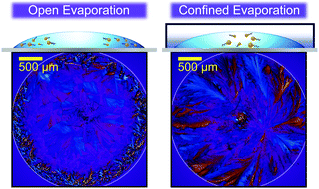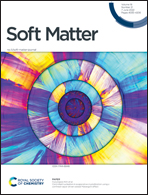Controlled nucleation in evaporative crystallization using a confined-vapor driven solutal Marangoni effect†
Abstract
In droplet evaporation, the onset of evaporative crystallization near a contact line is inevitable if there is a coffee-ring effect increasing the local concentration of suspended particles at the edge. In this study, we present a novel idea to control the nucleation location of surfactant crystallization by using the vapor-driven solutal Marangoni effects of a binary mixture drop in a confined chamber. Here, the evaporated volatile vapors near the droplet surface can change the local surface tension and generate a radially inward flow that suppresses the conventional coffee-ring flow (i.e., evaporatively-driven capillary flow). Using this method, we could accumulate suspended particles in the middle of the droplet. In consequence, we succeed in adjusting the nucleation location from the droplet edge to the center provided that a gel-transition process is neglected, where the crystallized material has a relatively long chain length. Here, we tested different hydrocarbon chain lengths of the surfactants (i.e., CTAB > TTAB > DTAB). We expect that the proposed idea can offer great potential for controlling the nucleation in the evaporative crystallization and its final crystalline solid morphology.



 Please wait while we load your content...
Please wait while we load your content...